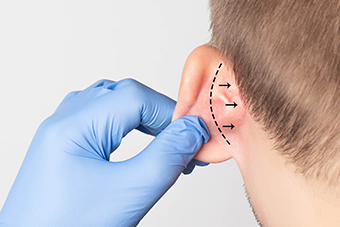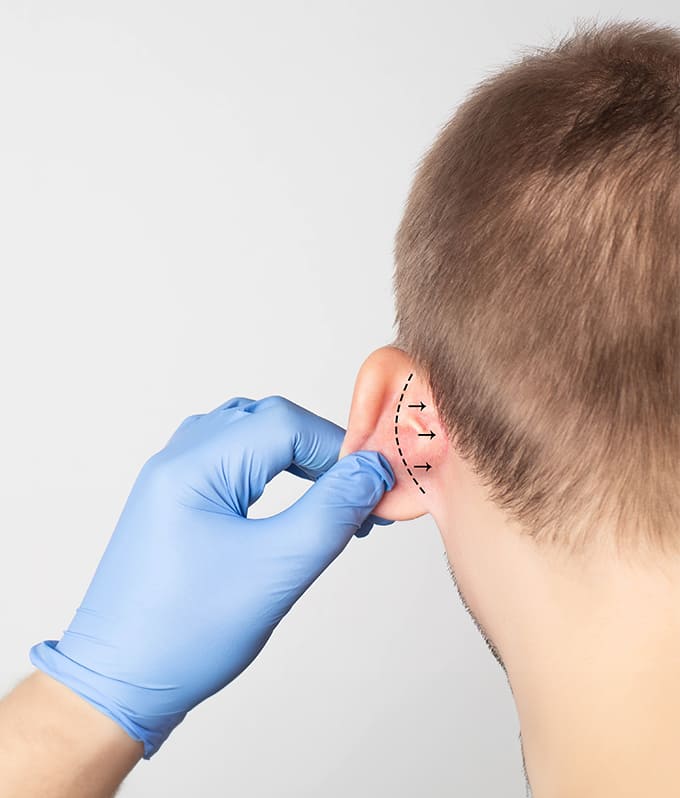Ear Correction - your professional Ear Correction in the Czech Republic
With an ear surgery the ears can be adjusted to the head by setting your ears back closer to the head or by reducing the size of large ears. Thanks to this cosmetic surgery it is possible to correct protruding ears. Protruding ears are usually a genetic predisposition. They can also appear in an asymmetric way, which can mean that one ear looks completely normal, whereas the second ear protrudes.
The reason why so many people suffer from protruding ears is because of teasing and mockery that they experience. In this sense an ear correction can be helpful for people who suffer from protruding ears to increase their overall happiness and their self-esteem. More often than not most people don’t even recognize the optical change. However, the patient who suffered a long time from the protruding ears can feel the relief after the operation.
Our cosmetic surgeons in the Czech Republic are specialized on the ear correction. In case you have any questions concerning the ear correction, we from cosmetic-op can support and accompany you.

Ear Correction from 650 €
Brief information about Ear Correction
Narkosis
Local anaesthesia
Duration
30 – 60 minutes
Stay in the clinic
ambulant
Headband
2 weeks day and night,
then 3 weeks at night
Sport
after 6 weeks
Strain
2 months no earrings
Hearing ability
will not be affected
Things to know about your Ear Correction in the Czech Republic
How much does Ear Correction cost?
Ear Correction both-sided
from 650 €
Before the Ear Correction
About 4 weeks before the surgery, you should reduce smoking. Moreover, alcohol should be avoided. On the day of the surgery you should not have your menstruation. About 2 weeks before the surgery you should not take anticoagulants (Aspirin, acetylsalicylic acid containing drugs). You should avoid sunbathing or solarium particularly on the face.
In order to conduct the surgery you need a blood count and an electrocardiogram. In case you want to have the results before your appointment with your surgeon, your general practitioner can provide you with them. In this case you can bring the results with you (the results should not be older than two weeks). However, it is not mandatory to conduct these tests beforehand. The tests that you need in order to decide if you are ready for the operation will also be made directly at the clinic
Process of the Ear Correction
Before the surgery you will be informed during a detailed consultation on how the surgery is done. During this consultation you will be informed about possible complications and risks. It is advisable that you write down all the questions you have concerning the surgery, before your appointment at the clinic.
The ear surgery is done under regional anaesthesia. Before the anaesthesia you will be advised by an anaesthetist about the risks, complications and possible alternatives to a narcosis. The anaesthetist will be present during the surgery. During narcosis risks or complications can occur, depending on previous diseases and your general state of health.
During an ear correction the auricular cartilage is reshaped. The incision is made behind the ear in order to expose the ear cup cartilage. The exposed auricular cartilage is reshaped by a wafer-thin incision depending on the type of the malformation. In order to fix the ear to the new position a very thin suture is made on the front side of the ear. The incision behind the ear is closed by a thin suture. Usually the scars are not visible from the front and hardly visible from the back, once the wounds are completely healed. After the surgery you get a head bandage which you have to wear for 2 weeks day and night.
After the Ear Correction
The stitches on the front side can be taken out after about 2 weeks; those behind the ear are self-dissolving.
After the head bandage has been removed you should wear a frontlet day and night for another 2 weeks. Then, the next 2 weeks only at night. After the stitches have been taken out you can wash your hair again but please be very cautious in order not to interfere in the recreation of the auricular cartilage.
After 3-5 days after the surgery you can take up your everyday activities again. You have to be very cautious when doing sports or other exhausting activities for about 6 weeks and you should protect the ears with a frontlet.

The description of the operation is generally phrased and can’t replace the personal consultation with the cosmetic surgeon. Unfortunately, we are not allowed to show before/after pictures, due to the fact that this is forbidden by the Law on Advertising in the Health Care System.
We gladly answer your questions
You can contact us Monday to Friday: 8am – 8pm
At the weekend: 1pm – 7pm
+49 (0) 8122 / 55 3 77 20





